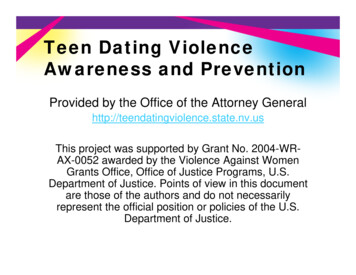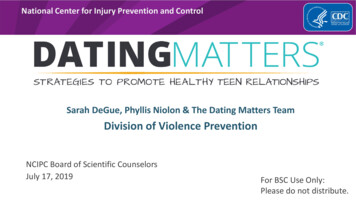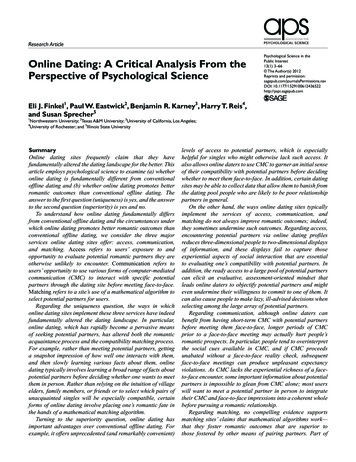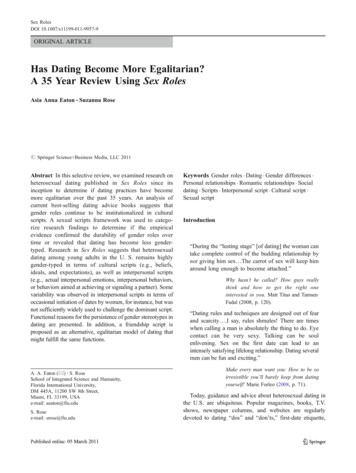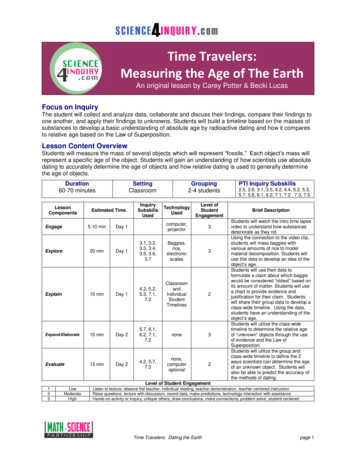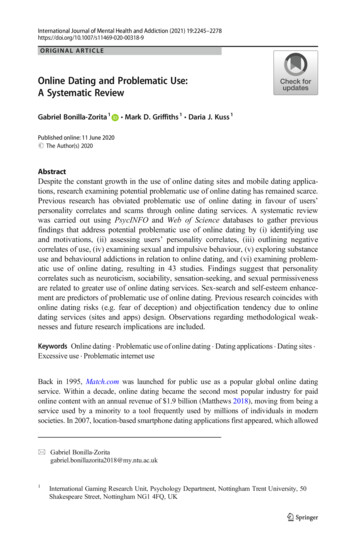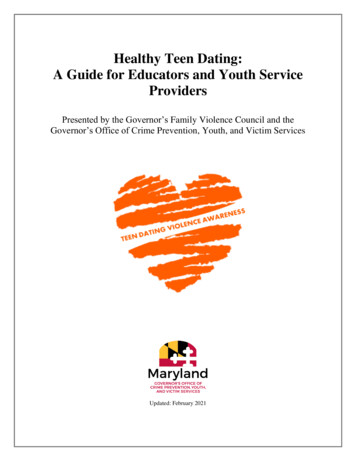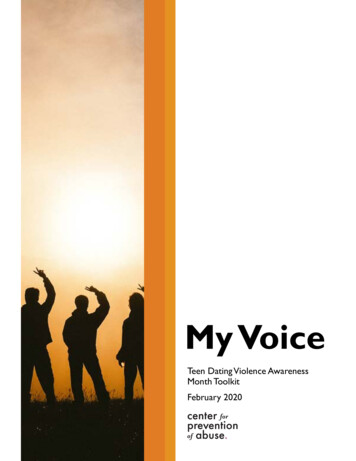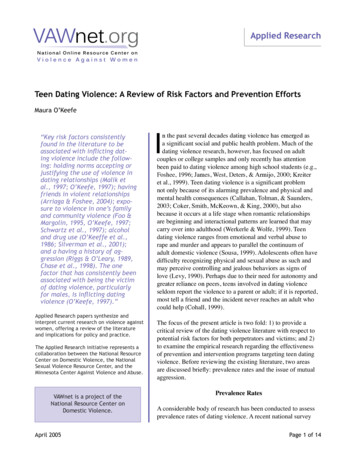
Transcription
Applied ResearchTeen Dating Violence: A Review of Risk Factors and Prevention EffortsMaura O’Keefe“Key risk factors consistentlyfound in the literature to beassociated with inflicting dating violence include the following: holding norms accepting orjustifying the use of violence indating relationships (Malik etal., 1997; O’Keefe, 1997); havingfriends in violent relationships(Arriaga & Foshee, 2004); exposure to violence in one’s familyand community violence (Foo &Margolin, 1995, O’Keefe, 1997;Schwartz et al., 1997); alcoholand drug use (O’Keeffe et al.,1986; Silverman et al., 2001);and a having a history of aggression (Riggs & O’Leary, 1989,Chase et al., 1998). The onefactor that has consistently beenassociated with being the victimof dating violence, particularlyfor males, is inflicting datingviolence (O’Keefe, 1997).”Applied Research papers synthesize andinterpret current research on violence againstwomen, offering a review of the literatureand implications for policy and practice.The Applied Research initiative represents acollaboration between the National ResourceCenter on Domestic Violence, the NationalSexual Violence Resource Center, and theMinnesota Center Against Violence and Abuse.VAWnet is a project of theNational Resource Center onDomestic Violence.April 2005In the past several decades dating violence has emerged asa significant social and public health problem. Much of thedating violence research, however, has focused on adultcouples or college samples and only recently has attentionbeen paid to dating violence among high school students (e.g.,Foshee, 1996; James, West, Deters, & Armijo, 2000; Kreiteret al., 1999). Teen dating violence is a significant problemnot only because of its alarming prevalence and physical andmental health consequences (Callahan, Tolman, & Saunders,2003; Coker, Smith, McKeown, & King, 2000), but alsobecause it occurs at a life stage when romantic relationshipsare beginning and interactional patterns are learned that maycarry over into adulthood (Werkerle & Wolfe, 1999). Teendating violence ranges from emotional and verbal abuse torape and murder and appears to parallel the continuum ofadult domestic violence (Sousa, 1999). Adolescents often havedifficulty recognizing physical and sexual abuse as such andmay perceive controlling and jealous behaviors as signs oflove (Levy, 1990). Perhaps due to their need for autonomy andgreater reliance on peers, teens involved in dating violenceseldom report the violence to a parent or adult; if it is reported,most tell a friend and the incident never reaches an adult whocould help (Cohall, 1999).The focus of the present article is two fold: 1) to provide acritical review of the dating violence literature with respect topotential risk factors for both perpetrators and victims; and 2)to examine the empirical research regarding the effectivenessof prevention and intervention programs targeting teen datingviolence. Before reviewing the existing literature, two areasare discussed briefly: prevalence rates and the issue of mutualaggression.Prevalence RatesA considerable body of research has been conducted to assessprevalence rates of dating violence. A recent national surveyPage 1 of 14
Applied Researchfound that approximately 12% of high schoolstudents reported experiencing physical violence ina dating relationship (Center for Disease Control,2000). However, rates of dating violence in highschool samples have been found to be as low as9% (Roscoe & Callahan, 1985) and as high as 57%(Cascardi, Avery-Leaf, O’Leary, 1994).The wide range in prevalence rates may be due toseveral factors. Similar to the research on spousalviolence, there appears to be no standard definitionof dating violence. Whereas some researchersinclude psychological and emotional abuse in theirdefinition of dating violence (e.g., intimidation,verbal abuse, and monitoring a partner’swhereabouts) (O’Keeffe, Brockopp, & Chew, 1986;Halpern, Oslak, Young, Martin, & Kupper, 2001),others use a more restrictive definition that includesonly physically violent acts such as slapping,pushing, hitting, kicking, choking, etc. (DeMaris,1992; Bookwala, Frieze, Smith, & Ryan, 1992).Complicating the matter is that sexual violence isoften excluded in the definition of dating violence.Another reason for the variation in prevalence ratesis that many studies consider violence in a singleor recent relationship and others consider violenceoccurring in multiple relationships (Arias, Samios,& O’Leary, 1987; Stacy, Schandel, Flannery,Conlon, & Milardo, 1994). Confusion regardingrates of violence also arises from the mingling ofperpetration and victimization data, that is, anyexposure to dating violence either as a perpetrator oras a victim are merely added together (Hotaling &Sugarman, 1990). Some researchers have noted thatrates of violence may be inaccurate. For example,since most dating violence research relies on selfreport, socially desirable responses or other biasesin reporting may affect prevalence rates (Sugarman& Hotaling, 1989). Males may tend to underreportand deny or minimize their own aggressionwhereas females may over report to accept blame(Jackson, 1999). Despite the problems in estimatingprevalence rates, it is not unlikely that physicalaggression occurs in one of three adolescent datingrelationships, an alarmingly high rate.Among high-risk youth, dating violence may be evenmore commonplace. One study found that amonga sample of 14 to 16 year old girls receiving childprotection services, over half had experienced sexualand physical violence at the hands of a dating partner(Wekerle & Wolfe, 1999). Another study foundthat 68% of males and 33% of females attendingan alternative school reported being violent againsta current or recent dating partner (Chase, Treboux,O’Leary, & Strassberg, 1998).Although studies are sparse, rates of datingviolence among gay, lesbian, and bisexual (GLB)youth are comparable or even higher than thosefor heterosexual couples (Elze, 2002; Freedner,Freed, Yang, & Austin, 2002). Threats of outing,such as threatening to reveal lesbian or gay identityto family, friends, ex-partners, or employers areparticularly high for bisexual adolescents (Freedneret al., 2002).Mutual AggressionImportantly, the dynamics of violent teen datingrelationships appear to differ from those of adultabusive relationships. Studies consistently indicatethat non-sexual violence in dating relationshipsinvolves the reciprocal use of violence by bothpartners. Several studies in fact have found that girlsinflict more physical violence than boys (Foshee,1996; Gray & Foshee, 1997; Malik, Sorenson,& Aneshensel, 1997; Roscoe & Callahan, 1985;O’Keefe, 1997). When sexual violence is examined,however, dramatic gender differences emerge withfemales sustaining significantly more sexual violencethan males (Bennett & Fineran, 1998; Foshee, 1996;Molidor & Tolman, 1998).It is important to note, that there are fundamentalproblems in asserting gender parity regardingrelationship violence. Most obvious is the greaterphysical harm that can be inflicted by male violencedue to males’ often-greater size and strength.Compared to boys, girls are more likely to sustaininjuries and require medical treatment as a result ofTeen Dating Violence: A Review of Risk Factors and Prevention Efforts (April 2005)Page 2 of 14
Applied Researchthe violence (Makepeace, 1987). Most of the datingviolence research has relied on the Conflict TacticScale (CTS) (Straus, 1979) an instrument that failsto address the meaning, context, or consequences ofthe violence (Dekeseredy, 1995). For example, muchof the dating violence research overlooks whetherfemale use of violence was in self-defense or inresponse to male physical or sexual violence.The few studies that have examined theconsequences of the violence have found genderdifferences with females reporting more negativeemotional consequences of the violence includingexperiencing greater fear for their safety (Foshee,1996). Molidor and Tolman (1998) found thatadolescent boys were less likely than girls toperceive incidents of dating violence as physicallyor psychologically threatening or damaging.O’Keefe and Treister (1998) found that malesand females perceive being the victim of datingviolence very differently. Whereas female victimsindicate “emotionally hurt” and “fear” as the twoprimary effects for them, males indicate “thoughtit was funny” and “anger.” Gender also appears toinfluence motives for violence. O’Keefe (1997)reported that whereas anger was cited as the mostfrequently mentioned motive by both males andfemales, self-defense was the second most frequentlycited motive for girls, but for boys it was the desireto get control over their partner. Also, Felson andMessner (2000) suggest that the control motive issignificantly more likely to occur in male-to-femaleviolence than any other gender combination. Giventhat fear, intimidation, power, and control are at thecore of adult battering relationships, it is critical tounderstand how these dynamics may be played outin adolescent relationships. Taken together, thesestudies suggest that despite gender parity in reportedrates of partner violence among adolescents, onecannot conclude that partner violence is a genderneutral phenomenon. More research, particularlyqualitative studies, are needed to enhance ourunderstanding of adolescent dating violenceincluding the nature of relationship conflicts as wellas the meaning, context, intent, and consequences ofthe violence.The next section provides a definition of riskfactors and a review of empirical studies on highschool samples that investigate risk factors for bothinflicting and sustaining dating violence.A Literature Review of Risk Factors for Inflictingand Sustaining Dating ViolenceRisk factors for dating violence may be definedas “attributes or characteristics that are associatedwith an increased probability of [its] reception and/or expression” (Hotaling & Sugarman, 1990 p.1).Although risk factors are thought to differentiateindividuals involved in dating violence from thosewho are not, it is important to note that they arecorrelates of dating violence and are not necessarilycausative factors. Consequently, these variablesmay have implications for the primary prevention ofdating violence, but they may also be symptoms oroutcomes that have implications for treatment.The following review organizes risk factors intoseveral categories: demographic characteristics, priorexperiences/exposure to violence, attitudes towardsviolence, peer influences, personality or intrapersonalfactors, other problem behaviors, and relationshipfactors.Demographic CharacteristicsAs with intimate partner violence, teen-datingviolence appears to occur in a wide range ofsocio economic strata (SES). Two studies foundhigher rates of dating violence in low SES groups(Makepeace, 1987; Sigelman, Berry, & Wiles, 1984);however, no consistent pattern has been found. Ratesof inflicting physical aggression against a datingpartner appear to vary by region with the higherrates found in urban inner city areas compared torural areas (Bergman, 1992; Makepeace, 1987).In addition, some differences have been found forrace/ethnicity, with higher rates of perpetrationfound among African Americans and lower ratesamong Asians and Latinos. Caucasians appear tofall in the middle of this continuum (Makepeace,1987; O’Keeffe et al., 1986; O’Keefe, 1997). OtherTeen Dating Violence: A Review of Risk Factors and Prevention Efforts (April 2005)Page 3 of 14
Applied Researchresearchers, however, report no racial differences inrates of dating violence when SES or other variableswere statistically controlled (Malik et al., 1997),indicating that factors other than race may accountfor the differences. Research on ethnic minoritygroups is limited due to small sample size. Also,samples have been frequently based on collegesamples where minorities and lower SES families areunderrepresented.With regard to other demographic factors, twostudies examined the effects of family structureon dating violence. Malik and colleagues (1997)found that family structure was a correlate of datingviolence for girls, whereas O’Keeffe et al., (1986)found that family structure was not associated withperpetrating or victimization of dating violence.Prior Experiences/Exposure to Prior ViolenceAn important variable examined repeatedly inthe literature on both dating and marital violenceis exposure to models of aggression in intimaterelationships. Studies hypothesizing a predictablerelationship between family of origin violence andinflicting dating violence have produced inconsistentresults with some studies indicating that teens,particularly males, who witness interparentalviolence are at higher risk for inflicting datingviolence (DeMaris, 1990; Foo & Margolin, 1995;O’Keefe, 1997), and other studies finding noeffect for witnessing interparental violence on thelikelihood of inflicting dating violence (Schwartz,O’Leary, & Kendziora, 1997). Compared to itsassociation with inflicting violence, witnessinginterparental violence appears to play a lesssignificant role in being the victim of dating violencefor both genders. Likewise, the link betweenexperiencing parent-child abuse and dating violenceappears to be equivocal with some studies indicatingthat being hit by parents is associated with later useof dating violence and others finding no association(Malik et al., 1997; O’Keefe, 1997). One studyfound that family violence variables (witnessinginterparental violence and parent-child violence)were significantly correlated on a bivariate basiswith receiving dating violence for both genders, butwere not significant in multivariate analyses wheremore proximal variables (i.e., those closer in timeor more related to the context in which the violenceoccurred) such as relationship or attitudinal factorsbecame more powerful influences (O’Keefe &Treister, 1998). A recent longitudinal study (Simons,Lin, & Gordon, 1998) found that although corporalpunishment by a parent was not associated withlater delinquency, it was associated with later teendating violence, suggesting that corporal punishmentspecifically “teaches that it is both legitimate andeffective to hit those you love” (p. 475).Exposure to community violence has also beenassociated with perpetration of dating violence forboth genders (Malik et al., 1997); for females, it hasbeen associated with being the recipient of datingviolence (O’Keefe & Treister, 1998). Exposure toviolence in the community may have a spillovereffect and increase one’s use of violence in intimaterelationships, perhaps by increasing one’s acceptanceof violence. Also, the more violence in one’scommunity the more likely a female is to become avictim of violence (O’Keefe, 1997).There has been consistent support in the literature fora positive association between dating violence andaggression against peers (Riggs & O’Leary, 1989).That is, adolescents who show a general tendencytowards aggression or who use physical aggressionagainst peers are also more likely to use aggressionwith a dating partner. Whereas some studies foundthis association for both males and females, anotherfound that general interpersonal aggression onlypredicted male use of dating aggression (Chaseet al., 1998). Not surprisingly, a strong positiveassociation has been found between prior use ofaggression against a dating partner and presentdating aggression suggesting that this behavior maypersist over time across relationships (Cano, AveryLeaf, Cascardi, & O’Leary, 1998).Attitudes Regarding Violence. One of the mostconsistent and strongest factors associated withTeen Dating Violence: A Review of Risk Factors and Prevention Efforts (April 2005)Page 4 of 14
Applied Researchinflicting violence against a dating partner is thebelief that it is acceptable to use violence (Maliket al., 1997; O’Keefe, 1997; Tontodonato & Crew,1992). In some studies, this association has beenfound to be stronger for males (Cate, Henton,Koval, Christopher, & Lloyd, 1982; Henton, Cate,Koval, Lloyd, & Christopher, 1983). Furthermore,males who initiated violence against their partnerwere more likely to expect positive consequenceswhereas non-violent males were more likely toexpect violence to dissolve the relationship (Riggs &Caulfield, 1997). Interestingly, several studies foundthat the relationship between witnessing parentalviolence and use of dating aggression was mediatedby acceptance of dating aggression, but that thiswas true for males only. In other words, for males,witnessing parental violence is associated withdating violence through its link with acceptance ofdating violence norms (O’Keefe, 1997). Similarly,Foshee, Bauman, and Linder (1999) reported thatthe association between exposure to family violenceand perpetrating dating violence was mediated byboth acceptance of dating violence as well as anaggressive conflict response style. This relationshipheld for both males and females.Peer InfluenceRelated to attitudes justifying dating violence,Arriaga and Foshee (2004) explored whetheradolescents follow in their friends’ footsteps.Findings indicated that having friends in violentrelationships was associated with an adolescent’sown experience as both a perpetrator and victimof dating violence. In fact, this variable was moreinfluential than the effects of witnessing interparentalviolence. In their longitudinal analysis (one of thefew studies that used a longitudinal design) friendviolence statistically predicted later inflicting datingviolence for both males and females, but friendviolence statistically predicted becoming the victimof dating violence for females only.Research findings regarding beliefs about traditionalsex roles show mixed findings. Theoretically,patriarchal beliefs and gender socialization processesare thought to groom females for victimization andmales for aggression in intimate relationships. Afew studies supported the view that females whomaintain traditional views regarding women’s rolesin society were more likely to be victims of datingaggression, while males who adopt traditional beliefsabout men’s roles are more likely to perpetrate datingviolence (Currie, 1983; Sigelman et al., 1984). Onestudy showed unexpected effects, that is, females’use of dating violence was associated with traditionalviews of women’s roles while males’ use wasassociated with less traditional views on men’s roles(Bookwala et al., 1992). This finding is particularlydifficult to explain and requires further researchexamining the meaning and intent of the violence.Personality or Interpersonal VariablesA number of intrapersonal variables have beencorrelated with relationship violence. Low selfesteem was found to discriminate between malesinitiating dating violence and their non-violentcontrols, but this pattern was not significant forfemales (O’Keefe, 1997). Similar to domesticviolence victims, low self-esteem was found to beassociated with being the victim of dating violencefor females, but not for males (O’Keefe & Treister,1998). Depression, more specifically sad andhopeless feelings, and suicidality were found to beassociated with victimization for both males andfemales in a nationally representative sample ofhigh school student (Kreiter et al., 1999; Howard &Wang, 2003a; Howard & Wang, 2003b). Notably,examination of low self-esteem and depression raisesthe question of causation and whether they are riskfactors, consequences, or related to dating violencethrough a third variable.Coping styles may be viewed as a psychologicalresource that assists individuals to cope with conflict.From a social learning theory perspective, skilldeficits, such as poor problem solving abilities,difficulty managing anger and communicatingfeelings would increase the likelihood of resorting toTeen Dating Violence: A Review of Risk Factors and Prevention Efforts (April 2005)Page 5 of 14
Applied Researchviolence to solve problems. Indeed, among a sampleof college freshmen, Bird, Stith, and Schladale(1991) reported that confrontive coping strategiescharacterized by anger, blaming, and trying to get thepartner to change differentiated between partners inviolent and non-violent relationships. Respondentsin violent dating relationships more often resorted toinsults, swearing, or cold and silent withdrawing tomotivate the partner to act according to their wishes.Other Problem BehaviorsAdolescents who engage in one problem behaviorare likely to engage in other problem behavior andthis appears to be the case for dating violence. Useof alcohol and drugs has been consistently foundto be strongly associated with inflicting and beingthe recipient of dating violence for both genders(Burcky, Reuterman, & Kopsky, 1988; O’Keeffe etal., 1986; O’Keefe, 1997; Silverman, Raj, Mucci, &Hathaway, 2001). An association between substanceuse and females experiencing sexual aggressionfrom dating partners has also been noted (Koss &Dinero, 1989). It has been hypothesized that sexistrape myths, suggesting that females who consumesubstances on a date are “fair game” and are partlyresponsible for their assault, may increase the risk ofsexual victimization by a dating partner (Marx, VanWie, & Gross, 1996). Clearly, altering sexist beliefsand attitudes that blame the victim need to be a focusof prevention programs.Other problem behaviors associated with femalesexperiencing dating violence include engaging inrisky sexual behaviors (e.g., having multiple sexpartners and nonuse of condoms), pregnancy, andunhealthy weight control (Silverman et al., 2001).The same risky sexual behaviors were also foundto be associated with males experiencing datingviolence. Again these correlational findings need tobe more fully understood. Future research is neededto determine the nature of the relationships betweenexperiencing dating violence and these health riskbehaviors and whether one form of behavior maytrigger another or whether all are part and parcel of arisk lifestyle.Relationship VariablesA number of relationship factors have beenassociated with both inflicting and receivingdating violence. Similar to college samples,greater relationship conflict and a greater numberof dating partners was positively associated withinflicting dating violence for both males and females(Bergman, 1992; O’Keefe, 1997). It is likely thatarguments or conflicts may set the stage for use ofviolence among some adolescents. For females,greater relationship conflict and less relationshipsatisfaction were significantly associated with beingthe recipient of dating violence (O’Keefe & Treister,1998). Again, given the cross sectional design ofmost of the research on dating violence, it is difficultto determine whether greater relationship conflictand less relationship satisfaction are risk factors orconsequences of the violence.Summary and Directions for Future ResearchDating violence among young adolescents is all toocommonplace. The physical and emotional consequences are well documented and it is likely thatits occurrence has implications for intimate adultrelationships. The methodological limitations suchas reliance on cross sectional designs and nonrepresentative sampling will need to be addressed infurther studies. The available data indicate that dating violence is multi-determined and that numerousfactors interact with one another to affect a particular outcome. However, the mechanisms by whichvarious factors are associated with dating violenceor how they may relate to each other are not fullyunderstood. Practitioners tell us that adolescents donot perceive of dating aggression as deleterious tothe relationship nor do they view violence as a causefor ending the relationship. Research to enhance ourunderstanding of gender and its importance in victimization and perpetration of interpersonal violenceas well as the meaning, context, and consequencesof dating violence is needed. Also, there is a paucityof research examining the experiences of datingviolence among gay, lesbian, and bisexual adolescents as well as high-risk adolescents, for exampleTeen Dating Violence: A Review of Risk Factors and Prevention Efforts (April 2005)Page 6 of 14
Applied Researchthose with known involvement in criminal relatedactivities or with substance abuse. The latter havebeen particularly neglected in the research literatureand given that they are a population at high risk forperpetration and use of violence in adult intimaterelationships, this gap is troubling. Also, researchidentifying resiliency factors that may interrupt thedevelopment of aggressive behaviors in dating relationships is needed.The extant research does provide enough informationto guide professionals to design prevention programsand target high-risk individuals. Taken together theresearch points to several key factors amenable tochange that should be targeted to prevent datingviolence. Altering norms associated with datingviolence, including dispelling myths that underlinethe acceptance and justification of violence, shouldbe a priority. Having friends in violent datingrelationships is predictive of one’s own involvementas well as use of violence highlights further theneed to alter social norms that condone, justify, andglamorize violence. A primary prevention programshould include education regarding the differentforms of relationship violence, early warning signs,understanding the dynamics of intimidation, power,and control that underlie relationship violence, andteaching skills for building healthy relationshipssuch as communication and conflict resolution.Further, despite some equivocal findings, exposureto family and community violence, alcohol and drug,a history of aggression appear to be vulnerabilityfactors that should be considered when targetinghigh risk groups. Importantly, given the possiblespillover effects of community violence on intimatepartner violence, programs that focus on reducingcommunity violence will likely reduce violence inadolescent dating relationships. The next sectionprovides a discussion of programs and reviews theresearch evaluating the effectiveness of specificdating violence prevention efforts.Prevention and Intervention ProgramsThere are only a handful of studies that haveempirically investigated the effectiveness ofprograms to prevent teen dating violence. Most areschool based and use a group format. Program lengthvaries from less than a day to more than 20 sessions.Whereas a few programs frame the issue of datingviolence using a feminist perspective, others usea more skills-based and gender-neutral approach.Most of the prevention programs attempt to targetcorrelates of dating violence such as attitudes aboutviolence and gender stereotyping or teach conflictmanagement or problem solving skills. Activitiesaimed at increasing awareness and dispelling mythsabout violence in relationships are often included inthe curriculum.The program Skills for Violence Free Relationships(Levy, 1984) is a multi-session curriculum foradolescents, which uses a gendered perspective, i.e.,it is an adaptation of programs for battered womenand focuses on males as perpetrators and females asvictims. Two evaluations of this prevention programhave been undertaken (Jones, 1987; Levy 1984), butneither demonstrated change in students’ attitudestoward use of violence.In Touch with Teens (Aldridge, Friedman, &Giggans, 1993) is an eight session curriculumcovering such topics as roots of violence, power andcontrol, cycle of violence, and building blocks ofa good relationships to name a few. An evaluationconducted on this program using a pre/post testdesign demonstrated expected change on severalitems pertaining to knowledge regarding healthyrelationships and knowledge regarding sexualharassment and sexual assault.Using a skill-based program focusing on attitudechange, skill enhancement, and support for helpseeking; Avery Leaf, Cascardi, O’Leary, and Cano(1997) implemented a five-session dating violenceprevention curriculum Building Relationships inGreater Harmony Together (BRIGHT). Healthclasses in a high school were randomly assigned toreceive the prevention program or no intervention.Findings revealed that students in the treatmentgroup showed significant reductions in their attitudesjustifying dating violence as well as a significantTeen Dating Violence: A Review of Risk Factors and Prevention Efforts (April 2005)Page 7 of 14
Applied Researchincrease regarding intention to seek help comparedto those in the no treatment group.Two interventions that did not use a comparisongroup have also been evaluated. One included anevaluation of a one-day violence prevention programinvolving community presentations targeting highschool students in Canada (Jaffe, Sudermann,Reitzel, & Killip, 1992). Findings indicatedsignificant increased knowledge regarding datingviolence for both males and females. However, therewas a backlash effect among some boys’ attitudes,that is, at posttest male students reported beingmore supportive of dating violence norms. Anotherinvolved an evaluation of a two or four sessionintervention (using a didactic and activities format)in a Canadian high school (Lavoie, Vezina, Piche, &Boivin, 1995). Findings indicated significant changein student’s attitudes in the desired direction.One of the largest attempts to evaluate a datingviolence prevention program was conducted byFoshee et al. (1998) and included school andcommunity based activities for 8th and 9th graders in arural county in North Carolina (N 1886). Fourteenschools were randomly assigned to treatment andcontrol groups. The Safe Dates program includedschool and community activities aimed at changingattitudes about violence and gender stereotyping,conflict management, and providing supportfor help seeking when violence occurred. Datacollected at a short one-month follow-up indicatedthat the Safe Dates program was effective inpreventing psychological, physical, and sexual abuseperpet
aggression occurs in one of three adolescent dating relationships, an alarmingly high rate. Among high-risk youth, dating violence may be even more commonplace. One study found that among a sample of 14 to 16 year old girls receiving child protection services, over half had experienced sexual and physical v

